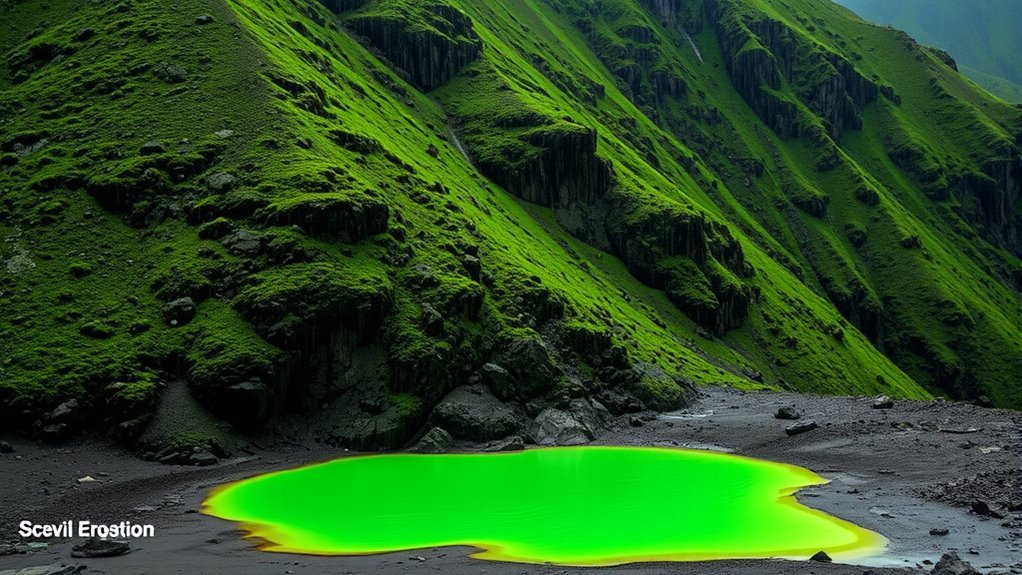Squalls can induce landslides and erosion in mountainous areas through sudden and intense rainfall. This rapid precipitation saturates the soil, reducing its cohesion and stability. As the soil becomes heavier, hydrostatic pressure can trigger movement downhill. Additionally, heavy rainfall can lead to surface runoff, which erodes slopes by transporting soil and debris. The combination of wind and rain exacerbates these effects. Further exploration reveals more complex connections between squalls, soil dynamics, and geological factors.
Main Points
- Squalls produce sudden, intense rainfall that saturates soil, decreasing cohesion and stability, leading to increased landslide risk in mountainous regions.
- Heavy rainfall from squalls enhances surface runoff, transporting soil and debris down slopes, which accelerates erosion processes.
- The rapid changes in weather associated with squalls can increase hydrostatic pressure in soil, further destabilizing slopes and triggering landslides.
- Wind gusts during squalls can dislodge loose soil particles, compounding erosion effects and reshaping the terrain in mountainous areas.
- Geological factors, such as steep slopes and certain rock types, amplify the susceptibility to landslides when combined with the effects of squalls.
Understanding Squalls: Definition and Characteristics
Squalls are sudden, intense bursts of wind and precipitation that can occur in various weather conditions, often associated with thunderstorms. These phenomena are defined by rapid changes in weather, typically leading to brief but heavy rainfall and strong gusts of wind.
Squalls can develop quickly, often catching individuals and communities off guard. They may last for only a few minutes to several hours, but their impact can be substantial.
In mountainous areas, squalls can lead to increased erosion and destabilization of slopes. The combination of intense rainfall and strong winds can saturate soil and compromise the structural integrity of slopes, making them more susceptible to landslides.
Additionally, squalls can create localized flooding, further exacerbating the risk of erosion. Understanding the attributes of squalls is essential for predicting their effects on the environment, particularly in vulnerable mountainous regions where landslides pose a serious threat to safety and infrastructure.
The Role of Soil Saturation in Landslide Triggering

When soil becomes saturated due to intense rainfall, it considerably increases the likelihood of landslides in mountainous regions. Saturation occurs when the pore spaces within the soil are filled with water, reducing the soil's cohesion and stability. This loss of strength can lead to the failure of soil layers, especially on steep slopes where gravitational forces are already at play.
As the water content rises, the weight of the saturated soil increases, further exacerbating the potential for movement. Additionally, the presence of water can create hydrostatic pressure, which contributes to the destabilization of soil structures.
Factors such as soil type, slope angle, and vegetation cover also influence how quickly saturation occurs and the likelihood of landslides. In the end, understanding soil saturation dynamics is vital for evaluating landslide risk in mountainous areas during and after heavy rainfall events.
Mechanisms of Erosion Induced by Intense Weather Events
Intense weather events, such as heavy rainfall and strong winds, can markedly accelerate erosion processes in mountainous areas. The rapid influx of water saturates the soil, increasing its weight and reducing cohesion between particles. This saturation leads to surface runoff, which can transport soil and debris down slopes with considerable force.
Additionally, heavy rains can trigger the formation of rills and gullies, further channeling water flow and enhancing erosion.
Wind, particularly during squalls, contributes to erosion by dislodging loose soil particles and carrying them away. The combination of wind and rain can create a synergistic effect, where the impact of raindrops dislodges soil, while wind disperses it.
These mechanisms not only reshape the terrain but can also lead to hazardous conditions, increasing the likelihood of landslides and sedimentation in nearby water bodies. Understanding these processes is crucial for managing erosion risks in vulnerable mountainous regions.
Geological Factors Influencing Landslide Susceptibility

The susceptibility of mountainous areas to landslides is considerably influenced by various geological factors. The composition and structure of the bedrock play a vital role, as certain rock types, such as clay and shale, are more prone to weathering and failure under stress.
Additionally, the slope gradient and the presence of fractures or faults in the rock can greatly affect stability. Steep slopes increase the gravitational force acting on materials, while fractured formations can promote water infiltration, leading to increased pore pressure.
Soil composition also matters; loose or unconsolidated materials are more susceptible to movement during intense rainfall.
Furthermore, the history of previous landslides in an area can indicate susceptibility, as recurring events often signal ongoing instability.
In general, understanding these geological factors is essential for evaluating and mitigating landslide risks in mountainous regions.
Impacts of Squalls on Mountain Ecosystems
Although squalls are often brief, their sudden onset can have considerable effects on mountain ecosystems. The intense rainfall and strong winds associated with squalls can lead to rapid soil saturation, increasing the likelihood of landslides and erosion. This disruption can uproot vegetation, altering habitats and affecting local biodiversity.
Moreover, the sudden influx of water can wash away nutrients from the soil, negatively impacting plant growth and stability. Aquatic ecosystems may also suffer as sediment runoff reduces water quality, harming fish populations and other aquatic organisms.
The disturbance of wildlife habitats can lead to shifts in animal behavior, as species may be forced to relocate in search of stable environments. Consequently, squalls can initiate a cascade of ecological changes, eventually reshaping the delicate balance of mountain ecosystems and influencing their long-term resilience against future climatic events.
Risks to Human Infrastructure in Mountainous Regions
As squalls sweep through mountainous regions, they pose considerable risks to human infrastructure, particularly due to their potential to trigger landslides and flash floods.
These phenomena can lead to the destruction of roads, bridges, and buildings, markedly disrupting transportation and emergency services. In areas where communities are situated close to steep slopes, the danger is exacerbated; heavy rainfall from squalls can saturate soil, increasing the likelihood of sudden landslides.
In addition, the rapid runoff can overwhelm drainage systems, leading to localized flooding and damage to urban planning initiatives. The economic consequences are significant, as repairs and preventative measures can strain local budgets.
Additionally, the safety of residents is jeopardized, necessitating timely alerts and evacuation plans. In the end, the interaction between squalls and mountainous terrain presents a persistent challenge for infrastructure resilience, demanding ongoing attention from engineers and planners.
Strategies for Mitigating Landslide Risks Associated With Squalls
Mitigating landslide risks associated with squalls requires a diverse approach that includes engineering solutions, land-use planning, and community preparedness.
Engineering methods such as retaining walls, drainage systems, and slope stabilization techniques can greatly reduce the likelihood of landslides. Effective land-use planning is essential; this involves restricting development in high-risk areas and encouraging vegetation restoration to improve soil stability.
Community preparedness is equally important, focusing on education and early warning systems. Local authorities can implement training programs to inform residents about landslide risks and emergency response procedures.
Additionally, regular monitoring of weather patterns and soil conditions will help identify potential hazards before they escalate.
Combining these strategies fosters a thorough risk management framework, enabling communities in mountainous regions to better withstand the impacts of squalls and safeguard both lives and infrastructure.
Emphasizing collaboration among stakeholders further improves the effectiveness of these mitigation efforts.
Common Questions
How Do Squalls Differ From Other Weather Phenomena?
Squalls are defined by sudden, intense bursts of wind and precipitation, differing from steady rainfall or gradual weather changes. Their abrupt nature often leads to rapid environmental impacts, unlike more stable weather phenomena that evolve slowly.
What Is the Average Duration of a Typical Squall?
The average duration of a typical squall varies, but generally lasts from a few minutes to a couple of hours. These brief yet intense weather events can considerably impact local conditions and atmospheric dynamics.
Can Squalls Occur Year-Round in Mountainous Areas?
Squalls can indeed occur year-round in mountainous regions, influenced by varying climatic conditions. Their frequency and intensity may fluctuate seasonally, but the potential for squalls remains present throughout the year, impacting local weather patterns considerably.
Are There Specific Regions More Prone to Squalls?
Certain regions, particularly mountainous areas with variable topography and climate, are more prone to squalls. These regions often experience rapid weather changes, leading to frequent occurrences of intense, short-lived storms that contribute to local weather patterns.
How Do Squalls Affect Wildlife Behavior in Mountains?
Squalls greatly influence wildlife behavior in mountainous regions. Animals often seek shelter during intense weather, altering feeding patterns and migration routes. These changes can disrupt local ecosystems, affecting species interactions and reproductive success in the affected areas.

